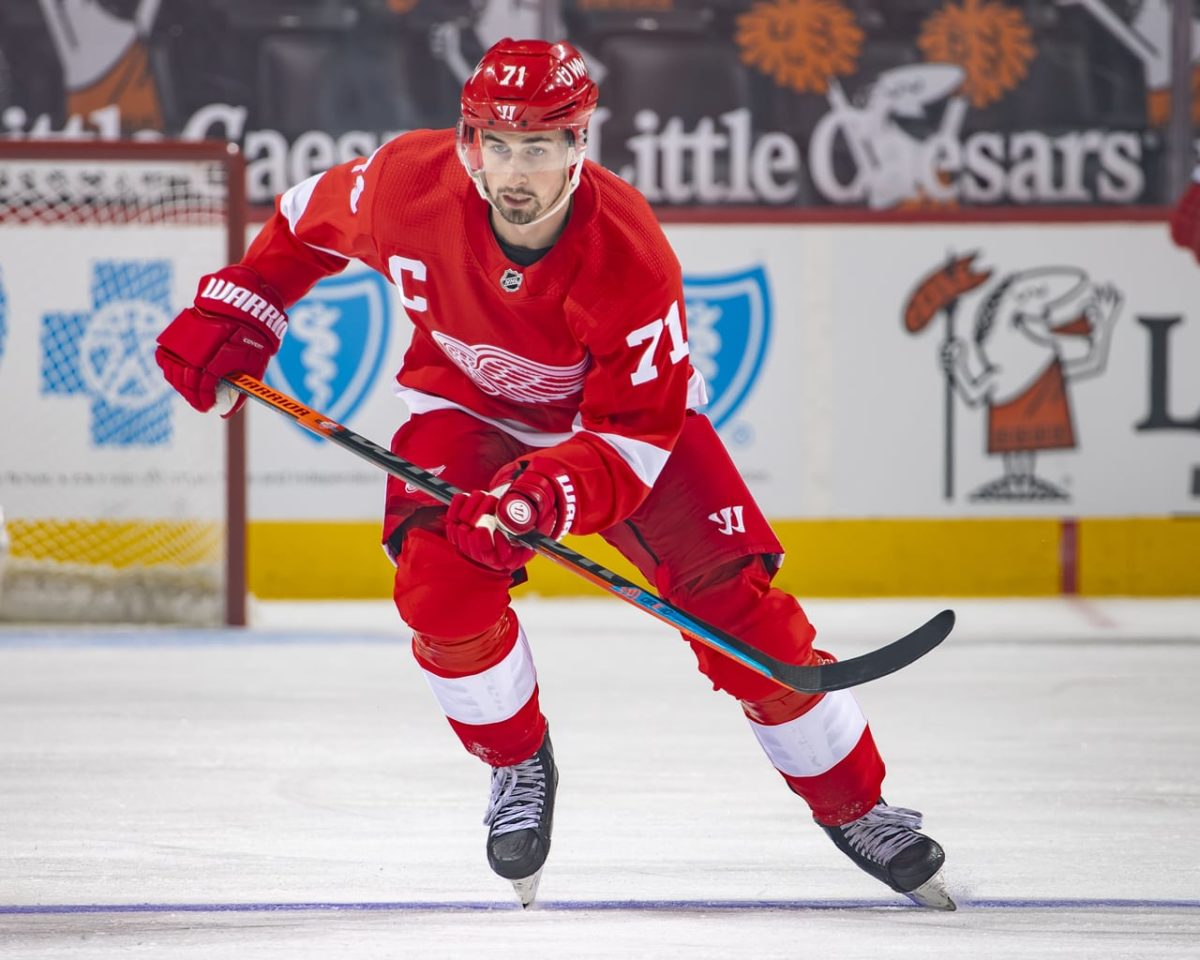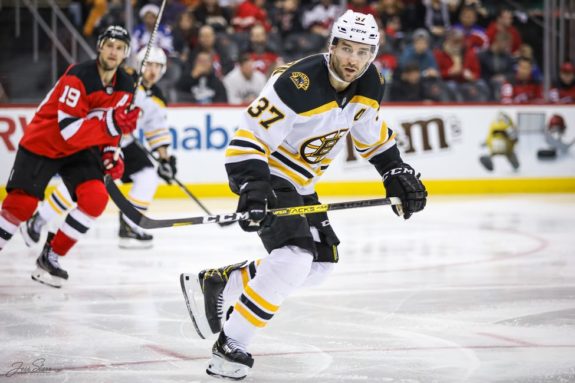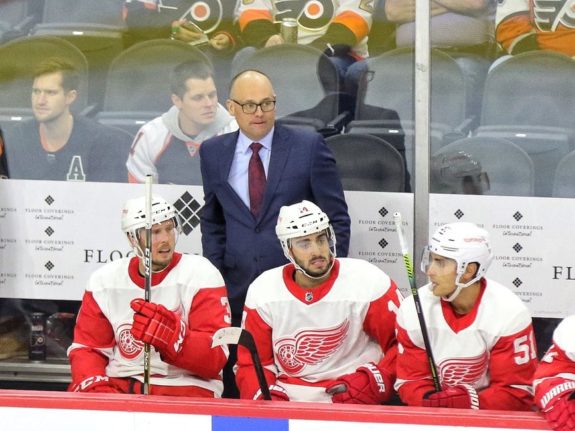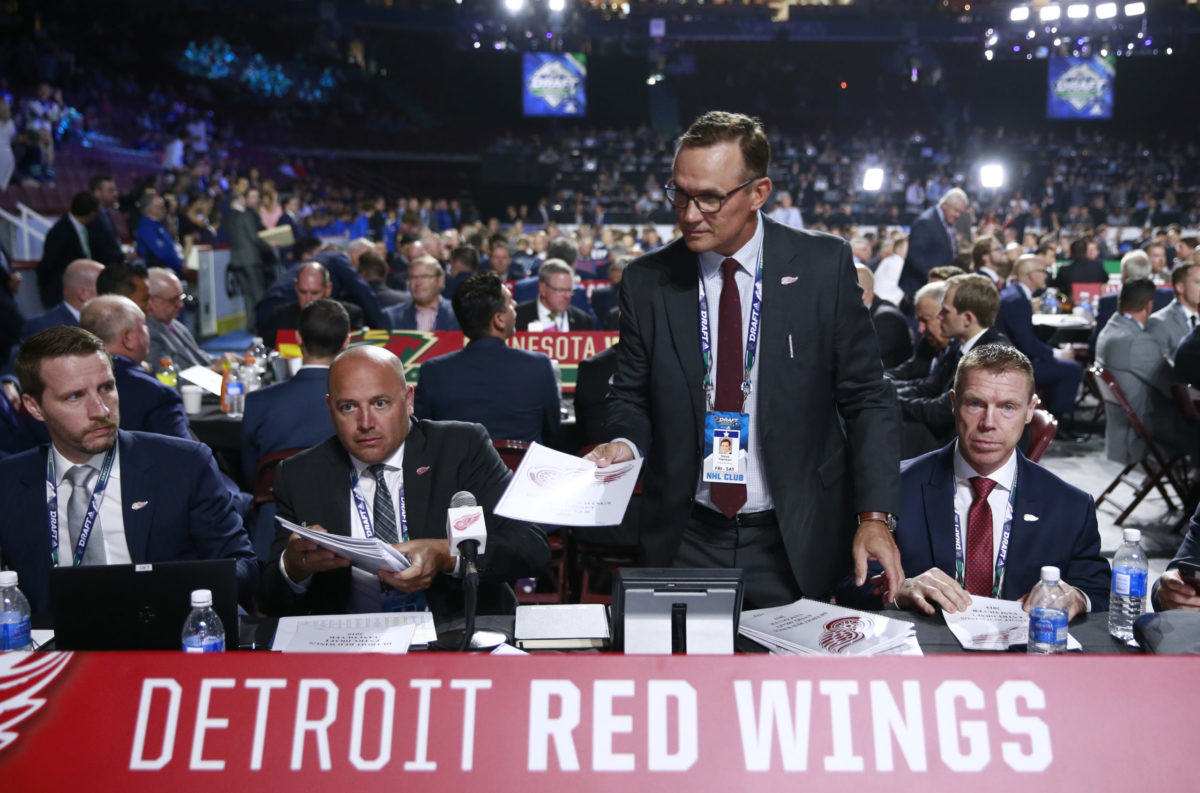It has been a little over a week since Detroit Red Wings general manager Steve Yzerman fielded questions from the media as the organization began their year-end/exit interviews. The biggest news, of course, was that the Red Wings’ GM had re-signed head coach Jeff Blashill, and a good amount of the questions he answered pertained to his thought process in making that decision. However, there was much more to be taken from Stevie Y’s answers as he is set to embark on his third offseason as the decision-maker in Detroit.
For reference, the entire press availability can be watched here:
Now let’s unpack Yzerman’s answers and see what insight they may offer as the Red Wings begin another crucial offseason in their ongoing rebuild.
1. Yzerman Not Worried About Larkin
Considering Red Wings captain Dylan Larkin collected points at the worst rate of his career since his second season in the league, it’s no wonder why comment boards are filled with fans that are worried that the 24-year-old forward is not the player they hoped he would be. Some fans have even outright turned on him and are hoping to see Yzerman trade him away in the coming years as the team continues to get younger and younger. These concerns are valid, but they are not shared by the Red Wings’ GM.
“You would never go home after a game and think ‘man, Dylan didn’t bring it today,'” Yzerman said regarding his captain’s effort level. As far as Larkin’s production, Yzerman mused, “as the talent level of our team improves, I’m not too worried about the production.”
Simply put: Yzerman feels that Larkin does not have the supporting cast he needs in order to produce at the level he is capable of. To me, this really jives with my evaluation of Larkin as a player, but I’ll get to that in a second.
In regard to what kind of player the GM expects his captain to become, he said, “Ultimately, I see Dylan Larkin as an outstanding two-way player. I don’t think we need him to lead the league in scoring. My goal for him is to strive to be one of the best two-way players in the game.”

This addresses a topic that my colleagues recently addressed on the most recent episode of THW Grind Line (which you can find and watch at the end of this article) – is Larkin really a first line center? In my opinion, the answer is yes, but it’s complicated.
We can all agree that Connor McDavid is a first line center, right? We can also agree that Patrice Bergeron is a first line center as well, yes? Now, can we also agree that McDavid and Bergeron are not even close to the same player? Alright, now that we’ve established that first line centers come in different forms, let’s talk about Larkin.
First of all, we need to establish that Larkin is closer to a Bergeron-type than he is to a McDavid-type. With that in mind, let’s look at how Bergeron enjoys so much success with the Boston Bruins. First off, he is one of the best two-way forwards in the game as evidenced by the fact that he has won the Frank J. Selke Trophy – awarded to the league’s best defensive-forward – FOUR times and has been a finalist for it five other times. Second, he has been able to produce at around a point per-game clip over the last four seasons due, in part, to the line he plays on. Dubbed “The Perfection Line”, the trio of Bergeron along with Brad Marchand and David Pastrnak are perennial possession monsters, and their production always puts them at or near the top of any “top lines in the NHL” rankings.
Yzerman stated that he wants Larkin to become one of the best two-way players in the league, much like Bergeron. The other thing Larkin is missing is two top-tier, elite-level wingers that help elevate his game in both the offensive and defensive end. This brings me to the point of how I evaluate Larkin.

Days after the 2020 draft, I wrote an article about why the Red Wings should commit to bringing in high-end wingers through the draft, free agency, trades, etc. I noted how the Chicago Blackhawks won three Stanley Cups by using Jonathan Toews as a top center, but everyone else beneath him on the depth chart were essentially just fillers. The real talent of those championship Blackhawks teams was on the wings, and on defense. This exact same approach can be seen with the Boston Bruins today, and I think that Larkin can be that Toews or Bergeron-type of player as long as there’s enough talent surrounding him.
Based on Yzerman’s comments, I would venture to say that he might think the same way.
2. Blashill is Yzerman’s Coach
It might be easy to forget, but Blashill’s recent contract that expired was announced by former GM Ken Holland on April 2, 2019. Yzerman was then introduced as the Red Wings’ next GM on April 19, just over two weeks later. It is foolish to believe that Yzerman did not have some sort of input in regard to retaining Blashill’s services. Since taking over the Red Wings, the GM has consistently praised his coach, even through the tough times that the 2019-20 season presented. He reaffirmed his liking for Blashill and the working relationship they have throughout his press conference last week.
“He’s very passionate and serious about his job,” Yzerman said of Blashill. He also remarked on how the coach is “determined to be successful in Detroit.”
Look, it doesn’t take much internet surfing to figure out that this move is the most unpopular decision Yzerman has made during his tenure in Detroit. Like someone flipped a switch, suddenly you see fans declaring that Yzerman doesn’t know what he’s doing, or that they will not be watching the Red Wings anymore until the coach is no longer with the team. To me, this decision is the first and perhaps truest test of whether or not you really “trust the Yzerplan”. It’s not about trusting the man when he fleeces a team in a trade, it’s about trusting him even if you’re initial reaction is “what are you thinking here, Steve?”

There are two interesting things about Yzerman’s answers regarding Blashill. One, he mentioned his working relationship with the coach a few times, leaving anyone to surmise that this is a GM that likes working with this coach. This is a business, and, like any other business, people like to keep around people they enjoy working with. With that in mind, he also made it clear that he does not fault Blashill for his losing record as the Red Wings’ coach (172-221-62).
“We have to have a better team,” Yzerman said. “It’s up to the management to provide players that make us a better team. You need good players to win in the league. I can change coaches year after year after year… we need to have good players, and if (we don’t), it’s not going to change.”
The great debate of “what comes first: the chicken or the egg?” can be reframed here as “what comes first: good players or good coaching?” When the Toronto Maple Leafs hired former Red Wing head coach Mike Babcock in the spring of 2015, they made it clear that they believed they needed to put a good coach in place before they could build a good team. In retaining Blashill, Yzerman has made it clear that he believes a good team must first be assembled before you can determine which coach should lead them to the promised land. The Red Wings’ GM put the impetus on himself to bring in those kinds of players, but he also made it known that he believes the players are responsible for how they play.
“I believe it is incumbent upon the players. You need a good team, and if I think our coach at some point is holding us back, I’ll address it at that point,” Yzerman said.
Yzerman also left the door open for Blashill to continue to be the Red Wings’ coach beyond this new extension. He remarked that the coach is still “young” and developing as an NHL coach. The idea is that Blashill is suitable for this phase of the Red Wings’ rebuild, but he could very well still develop into the coach that leads the way when the team enters the peak of their competitive window. The best-case scenario for all the “Hockeytown” faithful is that this is exactly what happens – the best-case scenario should be based on a group or individual’s success, not their failure.
The second interesting thing is that Yzerman is keen on how the coach has handled the team’s young players. “Jeff has shown (a willingness) to work with me in transitioning our young players into the lineup,” he said. “Being patient with them, not handing them positions. I think it’s important to have a coach that has that calmness, willingness and patience as kids go through growing pains.”
One of the biggest gripes that people have with Blashill is that he tends to lean into his veterans more so than he does his young players. While that can be true at times (fans grew painfully familiar with seeing Detroit’s fourth line on the ice when the team was down a goal with two minutes left in the game) it also doesn’t exactly line up with the ice time and opportunities given to guys like Filip Hronek, Filip Zadina, Michael Rasmussen and even Larkin. I think the proper critique here is that he leans on his veterans and top young players – it’s the in-between guys like Evgeny Svechnikov, Givani Smith, Gustav Lindstrom and Dennis Cholowski that tend to be on the outside looking in.
But isn’t that exactly what Yzerman is saying? He believes players must earn their opportunities by raising their games to meet their coach’s expectations. Players like Zadina and Rasmussen addressed some of the flaws in their respective games, and their ice-time reflected it. Players like Svechnikov and Cholowski maybe didn’t address those flaws as much or as successfully, and their respective roles reflected it. With Yzerman’s challenge that it is incumbent upon the players, he expects these players to give the coach zero choice other than to let them play.
(For the record, I also think there’s a bit of a numbers game going on as well. Yzerman is very much still waiting for Detroit’s worst contracts to fall off the payroll, but until then, it doesn’t make a ton of sense to pay somebody millions of dollars to watch the game rather than play in it. It may mean keeping a player like Smith down in Grand Rapids, but he is far from the only player in that position around the league.)
3. Yzerman’s Timeline
The question was about when Yzerman may feel the urge to make a “splash”, whether it’s in free agency or in a trade. The answer he gave, in my opinion, revealed more about what timeline the GM is aiming for than anything else he has ever said.
“I don’t think it makes a lot of sense for us to be trading draft picks and prospects for players that may not be here with us in four or five years,” Yzerman said.

Let’s take a look at where the Red Wings’ core group of players will be age-wise in four or five years:
- Dylan Larkin: 28-29 years-old
- Filip Hronek: 27-28
- Filip Zadina: 25-26
- Jakub Vrana: 29-30
- Moritz Seider: 24-25
- Lucas Raymond: 23-24
- 2021 first round pick: 22-23
All of Detroit’s core players will either be in their prime, or just entering it. While I think there’s reason to be optimistic that the Red Wings can start thinking about the playoffs a little bit sooner than that, this seems to be the timeframe that Yzerman expects the “Yzerplan” to really be in motion. So when he says he doesn’t want to acquire players that won’t be in Detroit in this timeframe, it’s because this is what he’s building towards. Acquring a veteran to help out in 2021-22 is one thing, but if that player won’t be a key piece in four or five years, he likely isn’t that interested.
Quick Hits
- According to Yzerman, Moritz Seider’s “next step” is the NHL. Start placing your Rookie of the Year bets now.
- In regards to goaltending prospect Keith Petruzzelli (88th overall, 2017) Yzerman said, “we’ve spoken with his advisors” about signing with Detroit. “I think Keith’s decision is does he stay in school or does he leave. That’s really his decision.” Personally, judging by Yzerman’s tone and body language, among other things, I am not confident in seeing Petruzzelli wear a Grand Rapids Griffins jersey, let alone a winged wheel. The 22-year-old goaltender has little left to prove at the collegiate level after being a finalist for the Hobey Baker Trophy this season as the NCAA’s MVP. If he returns to college to further his education, that is admirable and he should of course be allowed to do so, but I think it casts doubt on his overall willingness to play hockey in Detroit.
Want more Red Wings content? Tune into The Hockey Writers’ Grind Line — a weekly show on YouTube and Facebook. We stream weekly on The Hockey Writers YouTube channel. Check out our most recent show below, and make sure you subscribe to the channel so you don’t miss any upcoming shows.